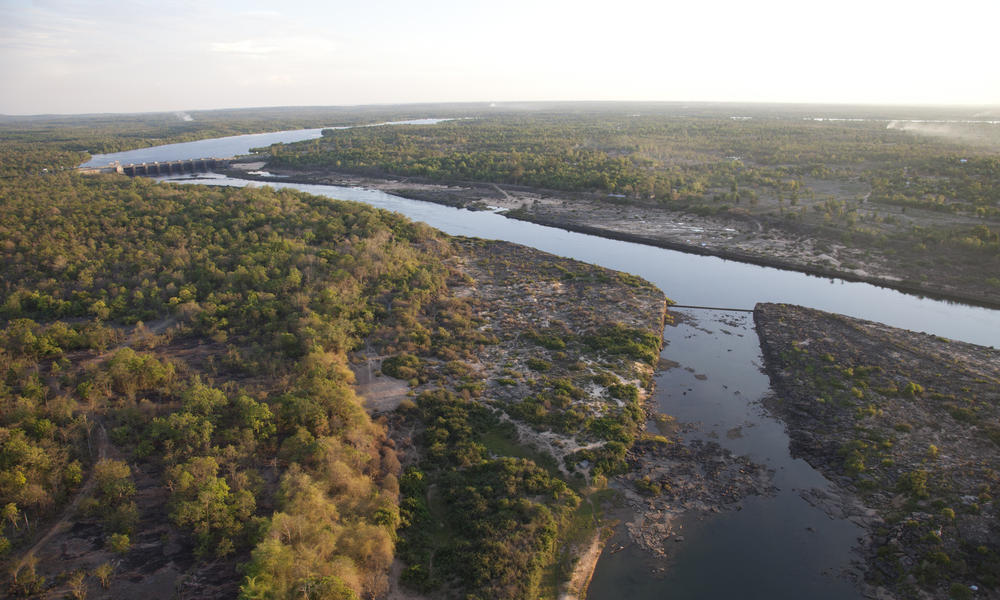Do you know that fishermen and Irrawaddy dolphins can collaborate in catching fish?
Irrawaddy dolphin, one of the endangered fish species in the world, is among 79 fish species thriving in the Ayeyarwady river. They can be found in Ayeyarwady, Ganges, Mekong and Mahakam rivers in the highlands of Borneo in Indonesia.
It was first found in the Ayeyarwady river; that’s how every freshwater dolphin around the world is called Irrawaddy dolphins and it was recorded as a new fish species found in Myanmar.
The Irrawaddy dolphin, with its scientific name as Orcaella brevirostris, is one of four endangered freshwater fish species in the world. They live in the upper course of Ayeyarwady river, helping farmers with their fishing.
If someone mentions dolphins, most people will see those which are trained professionally. Trained dolphins can make several performances such as leaping above the water surface and bending their bodies and diving, etc., however, Irrawaddy dolphins cannot do such things.
Irrawaddy dolphins are different in appearance from others, with their grey and dark grey colors, blunt snout and high, rounded forehead. It is, however, very interesting and fascinating that these Irrawaddy dolphins are helping fishermen to catch fish.
You can see Irrawaddy dolphins in the upper course of the river and they help fishermen from around Kyauk Myaung and Singu regions in Mandalay division.
Fishermen communicate with dolphins via their own signals in order to catch fish together with them, called cooperative fishing. Those signals include tapping the wall of the fishing boat with the stick, tapping the water with the row, etc.
Tapping the wall of the boat is signaling them to catch fish with them and tapping the water with the row is warning them to differentiate between enemies and friends.
The dolphins come to the fishing boat when they hear the signals and sometimes fishermen have to follow them.
Dolphins swim around the boat and scare the fish or they often signal the fishermen to catch the fish by slapping with their tails on the water. Then, the fishermen will start catching fish with fishing nets.
After that, the dolphins would feast on fish near the boat or fish that fall out of the net. That is how fishermen and dolphins cooperate with each other for fishing.
Sometimes, if the dolphins are not hungry, they would just help fishermen once or twice in fishing and they would tease them by avoiding their signals for fishing or blowing water to them.
Irrawaddy dolphins are not trained properly as those from international dolphin shows; they have been working together with fishermen to catch fish and it has been a tradition among them that is passed on to different generations.
This kind of cooperative fishing and culture exists only in Myanmar and only in the upper course of Ayeyarwady river in Myanmar.
Those Irrawaddy dolphins can also be found in Bangladesh and Coastal India, however, this culture of fishing together with fishermen can only be found in Myanmar. Therefore, it is important to cooperate with people and the government to prevent the extinction of Irrawaddy dolphins, one of critically endangered species.
In order to protect these Irrawaddy dolphins, Kyauk Myaung to Mingun region in the area of Ayeyarwady river was regarded as the Irrawaddy Dolphin Protected Area in 2005.

The protected area has several restrictions such as forbidding of catching or killing them for any reason, selling and buying parts of the dolphin or the whole, electrofishing in the area, suggesting to use fishing nets not bigger than width 600 feet and length 300 feet, and suggesting to free dolphins that are captured accidentally.
Moreover, the government has restricted other activities such as using mercury for gold mining and using environmental-friendly ways instead.
According to the U.S. based Wildlife Conservation Society (WCS), the protected area with an initial span of 74 kilometers (46 miles) of the river, was extended with a new 100 kilometers (62 miles) stretch running from the towns of Male to Shwegu in 2018.
However, seven Irrawaddy dolphins were dead in July 2020 amid those restrictions. 76 dolphins were found in 2018 and among them, six of them died, 72 dolphins were found and three died in 2019. 79 dolphins were found and seven died this year and it marks the most deaths within these 3 years.
The death of Irrawaddy dolphins is due to the electrofishing by fishermen and Irrawaddy dolphins are at the risk of extinction if we cannot prevent those actions.
Although the government has proclaimed rules and regulations on preventing electric fishing, there are still no effective actions taken and people are still not following those rules. This means not only Irrawaddy dolphin but also every fish species will be at the risk of extinction in the near future.
At the moment, fishermen are trying to catch more fish by not following the government’s rules and using electrofishing, which can even kill small fish. And it is also threatening the lives of Irrawaddy dolphins which are rare and endangered resources of the country.
The reason that fishermen use electrofishing for no specific reasons is maybe due to their poor knowledge of the consequences of their actions. And the government should provide effective training on how to maintain natural resources and what to avoid.
We believe that fishermen do not want the extinction of Irrawaddy dolphins that are helping them in fishing. Therefore, it is important to follow the rules and regulations, in order to prevent the extinction of the dolphins.
It is important to take actions against fishermen who use electrofishing, those who do not follow the rules and regulations made for fishing nets and those who are illegally fishing with excessive greed.
Although there are patrol actions taken by respective organizations, there should be more effective plans than this and more active participation by the government, since there are already seven deaths of Irrawaddy dolphins.
At the moment, it is only led by the Department of Fisheries and respective ministries, regional police and maritime police. Moreover, officials from the region and state government should be aware of those who are illegally fishing and should take serious actions against those.
If the government and people can cooperate and protect the Irrawaddy dolphins together, it can also attract tourists who love nature.
Kyaw Min Htin, the Associate General Secretary of Myanmar Tourism Federation, told Myanmar Insider, “We need to protect these endangered Irrawaddy dolphins although we cannot help improve the tourism sector with them. This is valuable for the country and it can also attract visitors in the future.”
Saw Htun, WCS’s Deputy Country Program Director for Myanmar, also said in the statement released in 2018 that the establishment of the new Ayeyarwady Dolphin Protected Area demonstrates the significant commitment of the Myanmar government to conserve this charismatic species of the Ayeyarwady river.
However, although other dolphins that grew up under the training in other countries, can attract visitors with their performances, there is still less interest in Irrawaddy dolphins.
In order for the tourism sector of the country to be developed, everyone should follow the rules and regulations set to maintain the natural resources of the country.
Translation by Hsu Myat Lin Naing










